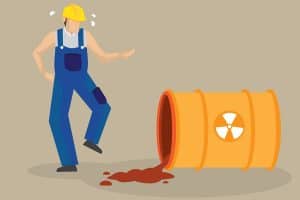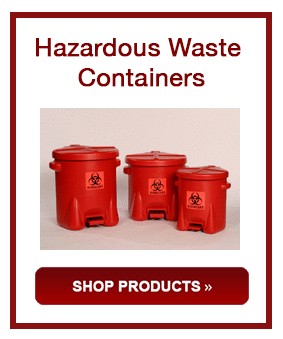 There are plenty of absorbents designed for multipurpose use. These types of absorbents — labeled “universal” — are appropriate for oil, water, and various chemicals. But there’s one type of spill your average absorbents simply can’t safely clean up: hazardous materials.
There are plenty of absorbents designed for multipurpose use. These types of absorbents — labeled “universal” — are appropriate for oil, water, and various chemicals. But there’s one type of spill your average absorbents simply can’t safely clean up: hazardous materials.
What makes hazmat absorbents special?
The Environmental Protection Agency (EPA) defines hazardous waste as any material “with properties that make it dangerous or capable of having a harmful effect on human health or the environment.” For this reason, regulations surrounding working with hazardous materials and cleaning up hazardous spills or leaks are different from regulations on other spill cleanups. If you work with hazardous materials daily, you need to be prepared for potential accidents and emergencies.
The Operational Safety and Health Association’s (OSHA) compliance guidelines include a requirement that any business in which employees could be exposed to hazardous materials as a result of spills must have a spill containment program. These programs require facilities be stocked with necessary materials and absorbents to clean up hazmat spills. The appropriate absorbents are designed for aggressive fluids and usually come in bright yellow to indicate caution around the spill and make them easy to identify in case of emergency.
Hazmat absorbents in the news
Hazardous material spills can happen in a wide variety of circumstances and industries, and someone must be responsible for dealing with any potential accidents.
For example, the Los Angeles Fire Department dispatched specialty hazmat units to a Walgreens parking lot in November 2017 when a truck leaked 10 gallons of diesel fuel into a parking lot just a hundred yards from the Santa Clarita River. The units used hazmat absorbents to soak up all the fuel in a 12-hour ordeal — and ultimately prevented the leaked diesel from traveling through storm drains and contaminating the nearby river.
A few months earlier and just on the other side of the river, hazmat teams weren’t so lucky containing a diesel spill 10 times the size of that in the Walgreens parking lot. Despite the Los Angeles Fire Department’s prompt five-minute response time, up to 100 gallons of diesel spilled into nearby storm drains.
But diesel isn’t the only hazardous material that can create dangerous spills that require hazmat absorbents. Recently, a hazmat team responded to a call regarding a chemical spill at a hospital in Madison, Wisconsin. The spill involved about five gallons of xylene, a chemical used in labs. Exposure to xylene can cause headaches, nausea, and vomiting, among other side effects. The team used absorbent materials to soak up the spill, then ensured the used materials were properly contained and safely disposed of.
Finding the best hazmat absorbents for the job
 If you’re looking for the best hazmat absorbents to stock in your facility or fleet of vehicles, AbsorbentsOnline has what you need. Our hazmat chemical absorbent socks, chemical spill absorbent pads and rolls, and hazmat absorbent pillows are the perfect all-purpose hazardous material absorbents to keep on hand in case of emergency. And once you’ve soaked up any spills, it’s important to ensure you have the appropriate hazardous waste containers to allow for proper disposal of used materials.
If you’re looking for the best hazmat absorbents to stock in your facility or fleet of vehicles, AbsorbentsOnline has what you need. Our hazmat chemical absorbent socks, chemical spill absorbent pads and rolls, and hazmat absorbent pillows are the perfect all-purpose hazardous material absorbents to keep on hand in case of emergency. And once you’ve soaked up any spills, it’s important to ensure you have the appropriate hazardous waste containers to allow for proper disposal of used materials.
If, like the recent spills near the Santa Clarita River, you might experience an outdoor spill that could threaten local bodies of water, it’s also important to be prepared to guard nearby storm drains. Drain protectors and spill containment dikes are just some of the stormwater management products available for this purpose.
Do you have the right materials ready to handle hazardous material spills? If you’re ready to set up your first auto-shipment of hazmat absorbents, contact our sales team at sales@absorbentsonline.com or (800) 869-9633.